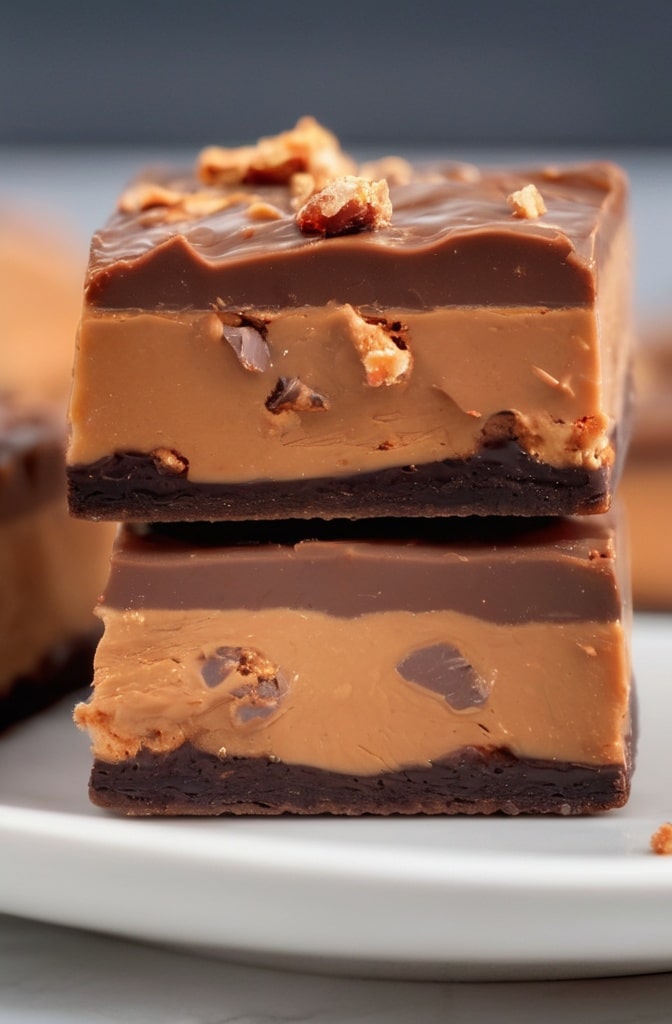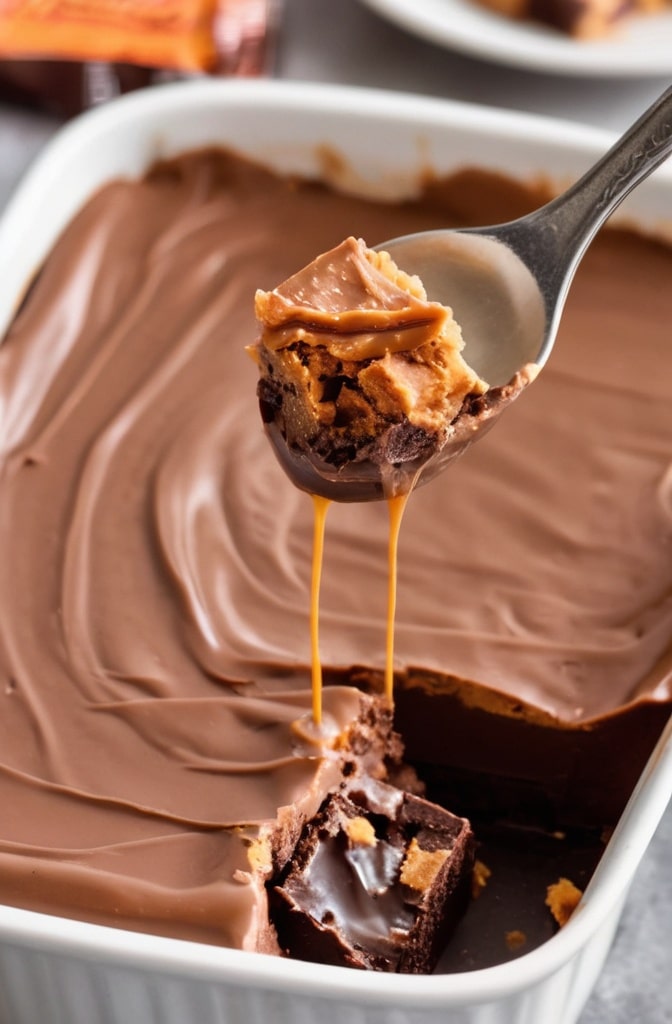The first time I attempted my Easy Butterfinger Fudge Instructions Recipe was during a chaotic holiday season at my cousin’s pastry shop. We’d run out of our signature chocolate truffles, and customers were gettin’ restless. With nothing but pantry staples and a bag of crushed Butterfingers, we created something that outsold our original confections three-to-one. That happy accident has since become my most requested recipe.
Butterfinger fudge stands apart in the confectionery world, bridging the gap between professional patisserie and nostalgic candy shop flavors. It combines the sophisticated silkiness of traditional chocolate fudge with the distinctive peanut-buttery crunch that makes Butterfingers irresistible. This recipe doesn’t just satisfy a sweet tooth it delivers a textural symphony that keeps people coming back for “just one more piece.”
Ingredients & Substitutions
For the Fudge Base:
- 3 cups (18 oz) high-quality white chocolate chips
- 1 can (14 oz) sweetened condensed milk
- 3 tablespoons creamy peanut butter (not natural style)
- 1 teaspoon pure vanilla extract
- ¼ teaspoon fine sea salt
- 1½ cups crushed Butterfinger candy bars (approximately 15 fun-size bars)
For the Topping (Optional):
- ½ cup crushed Butterfinger candy bars
- 2 tablespoons peanut butter chips
High-quality white chocolate makes all the diffrence in this recipe—cheaper brands often contain less cocoa butter and more stabilizers, resulting in a fudge that’s too sweet and lacks proper setting properties. I recommend Ghirardelli, Guittard, or Callebaut for professional results. The chocolate should contain cocoa butter as one of the first ingredients.
For those with peanut allergies, sunflower seed butter works remarkably well as a substitute, maintaining a similar texture while offering a slightly more nuanced flavor profile. Some of my clients even prefer it! If you’re avoiding dairy, coconut condensed milk creates an exceptional fudge with subtle tropical notes that complement the candy beautifully.
No Butterfingers on hand? While not identical, a combination of 1 cup crushed butter toffee bits and ½ cup crushed peanut brittle creates a comparable textural experience with a slightly more sophisticated flavor.
Step-by-Step Instructions

Preparation Phase
- Line an 8×8-inch baking pan with parchment paper, leaving overhang on two sides to create “handles” for easy removal. Pro tip: Lightly spritz the pan with cooking spray before placing parchment—this prevents shifting during the pouring phase.
- Crush Butterfinger bars thoroughly but not into dust. You want varying sizes from small crumbs to pea-sized pieces for textural contrast. The quickest method is pulsing them in a food processor with 2-second bursts, but placing them in a sealed bag and using a rolling pin works well too, giving you more control over particle size.
- Measure all ingredients before beginning. Temperature consistency is crucial for fudge making, and hunting for ingredients mid-process can lead to crystallization or separation. A common mistake is rushing the prep—give yourself about 15 minutes to properly organize your mise en place.
Cooking Process
- Create a double boiler by placing a heat-resistant bowl over a saucepan with 1-2 inches of barely simmering water. The water should never touch the bottom of the bowl. Excessive heat is the enemy of chocolate work, causing it to seize or become grainy.
- Add white chocolate, condensed milk, and peanut butter to the bowl. Stir continuously with a silicone spatula until about 90% melted, then remove from heat. The residual warmth will complete the melting process, preventing overheating which can destabilize the emulsion.
- Once removed from heat, add vanilla extract and salt, stirring until completely smooth. If your mixture appears slightly grainy at this stage, add 1 teaspoon of warm heavy cream and whisk vigorously—this often rescues a breaking mixture.
- Allow the mixture to cool for approximately 3-5 minutes until it reaches about 140°F (60°C). This is the perfect temperature for folding in mix-ins—too hot and the candy will melt completely; too cool and the fudge becomes difficult to spread.
- Fold in crushed Butterfinger pieces using a figure-eight motion rather than stirring in circles. This incorporates the candy while maintaining its texture and prevents air pockets. Reserve a handful of crushed pieces for the topping if desired.
- Working quickly but carefully, transfer the mixture to your prepared pan. For a perfectly smooth top, don’t spread with a spatula—instead, lift and gently tap the pan on the counter several times to create an even layer and release any air bubbles.
Finishing Touches
- If using the optional topping, sprinkle the remaining Butterfinger pieces and peanut butter chips over the surface while the fudge is still warm. Press them gently into the top with the back of a clean spatula or with your fingertips very lightly coated in neutral oil.
- Allow the fudge to cool at room temperature for 30 minutes, then transfer to the refrigerator for at least 3 hours, preferably overnight. Rushing this step leads to fudge that’s too soft to properly cut and serve.
- Once set, use the parchment handles to lift the fudge from the pan. For professional-looking pieces, warm a chef’s knife under hot water, dry completely, and make clean cuts, wiping and rewarming the blade between each cut. For perfect squares, trim the edges first (chef’s bonus snacking material).
Cooking Techniques & Science
The magic of Butterfinger fudge happens at the molecular level. Traditional fudge requires precise sugar crystallization, but this quick version uses white chocolate’s crystal structure and fat content to achieve stability. The cocoa butter in white chocolate forms beta crystals when cooled properly, creating that satisfying snap and melt-in-your-mouth quality.
Peanut butter serves dual purposes here—its emulsifying properties help bind fat and water molecules together for a smoother texture, while its flavor amplifies the Butterfinger’s distinctive taste. Research from food scientist Harold McGee suggests that the combination of roasted peanut compounds with vanillin (present in both the extract and candy) creates a synergistic effect that enhances perceived sweetness without additional sugar.
Temperature control is paramount throughout this process. The ideal working range for this fudge is between 115-125°F when adding mix-ins. I’ve seen countless students fail by eyeballing this step—invest in an instant-read thermometer for consistent results. If the mixture exceeds 130°F when adding the candy pieces, they’ll dissolve entirely rather than maintaining their signature crunch.
The condensed milk provides both sweetness and crucial milk proteins that help emulsify the mixture. These proteins surround fat molecules, keeping everything harmoniously blended and preventing the greasy separation that plagues many homemade fudge attempts.
For altitude adjustments above 3,500 feet, reduce the condensed milk by 1 tablespoon and increase peanut butter by ½ tablespoon to compensate for faster evaporation and lower boiling points.
Serving & Pairing Suggestions
Butterfinger fudge reaches its peak flavor complexity after aging for 24 hours in the refrigerator. Before serving, allow it to temper at room temperature for 15-20 minutes—this allows volatile aroma compounds to activate, enhancing the sensory experience considerably.
For an upscale dessert presentation, try cutting the fudge into 1-inch cubes and arranging them on a slate board with fresh berries and a drizzle of warm caramel sauce. The acidity from the berries cuts through the richness while complementing the candy’s flavor notes.

Beverage pairings make this simple confection truly shine. A medium-roast coffee with nutty undertones beautifully echoes the peanut butter elements. For wine enthusiasts, a tawny port offers complementary caramel notes, while a Moscato d’Asti provides contrasting brightness against the fudge’s richness.
Consider these complementary dessert pairings:
- Salted caramel gelato
- Browned butter shortbread cookies
- Banana pudding with vanilla wafers
For gifting, package pieces in parchment paper then wrap in gold foil. Professional confectioners know presentation amplifies perception—studies show that attractive packaging can increase perceived flavor quality by up to 30%.
When serving at events, I often create a “deconstructed” version: small fudge squares alongside tiny scoops of peanut butter mousse and a sprinkle of feuilletine for added texture. Guests inevitably rave about this “sophisticated” approach to a nostalgic flavor.
Storage & Shelf Life
Properly stored in an airtight container, Butterfinger fudge maintains peak quality for up to two weeks in the refrigerator. The flavor actually improves during the first 48 hours as the candy pieces slightly soften and their flavor compounds integrate more fully with the fudge base.
For longer storage, this fudge freezes beautifully for up to three months. Wrap individual portions in wax paper, then aluminum foil, before placing in freezer bags. This prevents freezer burn while containing the strong aroma that might otherwise transfer to neighboring foods.
When thawing frozen fudge, transfer portions to the refrigerator for gradual warming over 8-12 hours. Rapid temperature changes can cause sugar bloom—those unappetizing white spots that indicate sugar crystallization on the surface.
Variations to Consider
The basic formula offers endless creative possibilities for the experimental chef:
- Spiced Butterfinger Fudge: Add ¼ teaspoon of cayenne pepper and ½ teaspoon of cinnamon for a Mexican chocolate-inspired variation that balances heat with the candy’s sweetness.
- Salted Caramel Swirl: Before the fudge sets, swirl in 3 tablespoons of slightly cooled salted caramel sauce for dramatic visual appeal and flavor complexity.
- Espresso Butterfinger Fudge: Dissolve 1 tablespoon of espresso powder in the vanilla extract before adding to intensify the chocolate notes and add sophisticated depth.
- Butterfinger Fudge Brownies: Use this fudge as a frosting layer on brownies, applying while the fudge is still warm but not hot. The textural contrast between brownie and fudge creates an unforgettable dessert experience.
For special dietary needs, I’ve successfully created a vegan version using coconut condensed milk, plant-based white chocolate, and sunflower seed butter. While the texture is slightly softer, the flavor profile remains remarkably close to the original.
Common Pitfalls & Troubleshooting
Even experienced confectioners encounter challenges with fudge. Here’s how to address common issues:
- Fudge too soft: Usually indicates insufficient cooling time or too much moisture. Solution: Return to refrigerator for additional setting time or, in extreme cases, gently reheat and add 2 tablespoons of melted white chocolate to stabilize.
- Grainy texture: Often caused by crystallization from overheating or rapid temperature changes. Prevention is key—maintain gentle, even heating and avoid sudden cooling.
- Oil separation: Typically results from incompatible ingredients or overheating. If this occurs, remove from heat immediately, add 1 tablespoon of warm heavy cream, and whisk vigorously to re-emulsify.
- Butterfingers dissolving completely: Mixture was too hot when candy was added. Next time, cool the chocolate mixture more before folding in the candy pieces.
- Fudge won’t set properly: Usually indicates a ratio issue with condensed milk and chocolate. Add additional melted white chocolate (¼ cup at a time) and return to refrigerator.
Conclusion
Butterfinger fudge represents that perfect marriage between professionally-executed confectionery and accessible, nostalgic flavors. The contrast between the silky-smooth fudge base and the distinctive crispy, peanut-buttery Butterfinger pieces creates an eating experience that’s greater than the sum of its parts.
What makes this recipe truly special isn’t just its flavor profile—it’s the ease with which even novice candy-makers can achieve professional results. The forgiving nature of this method eliminates many traditional fudge-making pitfalls while still delivering that satisfying texture that defines quality confections.
Whether you’re preparing gifts for the holidays, catering for events, or simply indulging your own sweet tooth, this recipe offers endless possibilities for customization while maintaining its fundamental appeal. The techniques you’ve mastered here translate beautifully to other quick fudge variations—consider it the foundation of your confectionery repertoire.
Remember that perfection comes with practice. Each batch will teach you something new about chocolate work, temperature control, and flavor balancing. That’s the true joy of confectionery—there’s always another delicious lesson to learn.
FAQs About Butterfinger Fudge Instructions Recipe
Can I use milk chocolate instead of white chocolate in this recipe?
Yes, but you’ll need to adjust the ratios. Use 2½ cups milk chocolate chips instead of 3 cups white chocolate and reduce the peanut butter to 2 tablespoons. The resulting fudge will have a more traditional chocolate taste that somewhat competes with the Butterfinger flavor rather than highlighting it.
Why did my Butterfinger pieces sink to the bottom of the fudge?
This typically happens when the base mixture is too warm when you add the candy. The chocolate coating on the Butterfingers melts, making the pieces heavier, causing them to sink. Let your mixture cool to about 120°F before folding in the candy for more even distribution.
How do I prevent my fudge from becoming too sweet?
Balance is key in confectionery. Add an additional ¼ teaspoon of salt to the base and consider using 70% white chocolate if available. Some professional confectioners also add 1 teaspoon of unsalted butter to mellow the sweetness without compromising texture.
Can this fudge be made in advance for large events?
Absolutely! This is one of those rare desserts that improves with time. Make it up to five days ahead and store in the refrigerator. For optimal flavor release, slice the fudge the day before your event and store pieces separated by parchment in an airtight container.
What’s the best way to cut this fudge into clean, professional-looking pieces?
Chill the fudge thoroughly (minimum 4 hours), then use a large chef’s knife dipped in hot water and dried between each cut. For perfectly even squares, use a ruler as a guide and trim the edges first. For elegant service, try cutting into narrow rectangles (1×2 inches) rather than traditional squares.

